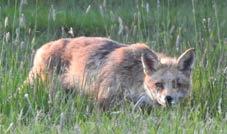
2 minute read
NATURE NOTES
Small Copper and Hoverfly Day flying insects such as our familiar hoverflies can be seen anywhere flowers grow, as they search for nectar on sunny days. They are one of our most important pollinators and almost 300 species have been recorded in the UK. Most are black and yellow and can look convincingly like stinging insects, providing an effective deterrent against predators.
Increasing numbers of moths are now on the wing, some active in sunshine such as the colourful Scarlet Tiger in its flight season of May to June. Most of our spectacular hawk-moths emerge in early summer, including the beautiful Lime Hawk-moth.
Advertisement
It is possible to see close to 20 butterfly species in our gardens if we grow flowers and shrubs to attract them. The fast-flying Small Copper can sometimes be seen visiting Golden Rod, Tansy, Aster, sedums and scabious. Others, may be found in specific habitats where their larval food plants are found, including woodland and meadows.
Perhaps one of our most unusual looking insects is the nationally scarce Cramp-ball Fungus Weevil, named after its dependence on a brittle, black fungus with a common name that refers to the resemblance to King Alfred’s burnt cakes, on which it feeds. The fungus grows only on its host tree ash and the weevil can ‘accidentally’ appear in gardens with log deliveries.
Often overlooked, woodlice on their diet of decomposing plant debris and fungi help to ‘clean up’ at ground level. Not an insect but a crustacean, it can only survive for minutes away from a damp environment. There are around 30 UK species.
Fox and badger cubs born in early spring will now be venturing out to enjoy the sunshine and learn skills necessary for survival. With a quarter of UK mammals now at risk of extinction, it is especially important that we respect and protect those we are still lucky enough to be living alongside and sharing our beautiful countryside.
Cramp-Ball Fungus Weevil























